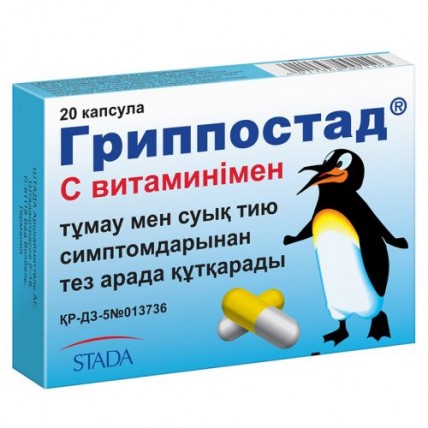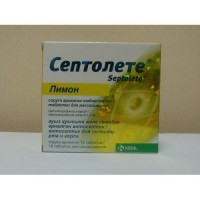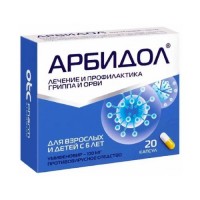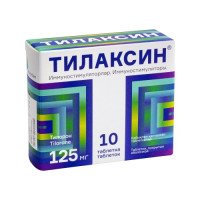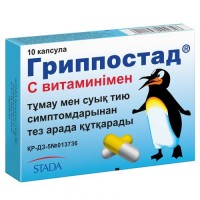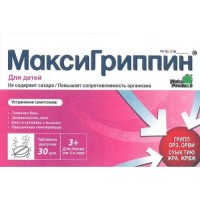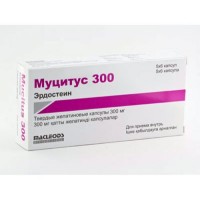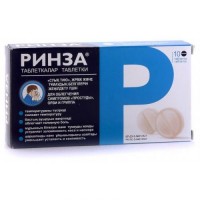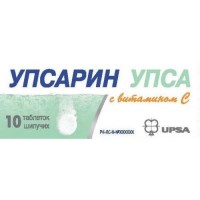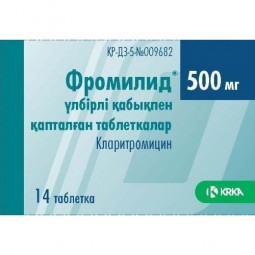The instruction for medical use
of Grippostad® medicine
the Trade name
of Grippostad®
the International unlicensed name
Is not present
the Dosage form
of the Structure One Capsule Capsule contains
active agents: DS paracetamol 208 mg
(the containing paracetamol of 200 mg, gelatin of 8 mg)
ascorbic acid FS 160 mg
(containing ascorbic acid of 150 mg, a glitserola tristearate of 10 mg)
caffeine 25 mg
chlorphenaminum a maleate 2.5 mg,
excipient - lactoses monohydrate,
structure of a cover of the capsule: gelatin, titan E171 dioxide, quinoline yellow E104, dye yellow Sunset of E110.
The description
Solid gelatin capsules 1 of No. in size, with an opaque yellow lid and the opaque white body. Contents of capsules - white or yellowish powder
Pharmacotherapeutic group
Analgetics and antipyretics. Paracetamol in a combination with other drugs.
The code of automatic telephone exchange N02BE51
the Pharmacological
Pharmacokinetics Paracetamol Later properties of intake paracetamol is quickly and completely soaked up from digestive tract. The peak of plasma concentration is reached in 30-60 minutes after reception.
Paracetamol is quickly distributed in all body tissues. Indicators of concentration of paracetamol in blood, blood plasma and saliva are comparable among themselves. Linking with proteins of blood plasma low.
Paracetamol metabolism, is generally carried out in a liver by conjugation with glucuronic and sulfuric acids. At reception of the doses exceeding therapeutic there is a fast saturation of conjugation test to sulphuric acid. Partially metabolism of paracetamol is carried out with the participation of the system of P450 cytochrome (mainly CYP2E1) that N-acetyl-r-benzokhinonimina which detoxication is carried out by glutathione and also linking with cysteine and mercapturic acid leads to formation of a metabolite. In case of the profound intoxication the quantity of toxic metabolites increases.
Removal of paracetamol happens, mainly, to urine. 90% of the soaked-up quantity are removed within 24 hours through kidneys, less than 5% - in not changed look. Elimination half-life makes about 2 hours. At patients with abnormal liver functions and kidneys and also at overdose and at newborns the elimination half-life is extended. The maximum effect and average duration of action (4-6 hours) correlates with the level of plasma concentration.
Caffeine
After intake caffeine quickly and almost is completely soaked up and its bioavailability is approximately equal to absolute. After reception of 5 mg/kg of Cmax it is reached within 30-40 minutes. Linking with proteins of blood plasma varies from 30 to 40%, and the volume of distribution is 0.52 - 1.06 l/kg. Caffeine is distributed on all bodies and fabrics, quickly gets through hematoencephalic and placentary barriers and is removed with breast milk.
Elimination half-life makes from 4.1 to 5.7 hours, however, depending on individual fluctuations, can raise till 9-10 o'clock.
Caffeine and its metabolites are removed, mainly, through kidneys. In urine, 86% of the accepted dose out of which only 1.8% are brought in the form of not changed caffeine are found. The main metabolites are 1-methyl-uric acid (12-38%), methylxanthine (8-19%) and 5-acetylamino-6-amino-3-methyluracil (15%). 2-5% of the accepted dose are removed with a stake. 44% of total number of metabolites are made by 1.7-dimethyl uric acid.
Ascorbic acid
Ascorbic acid is absorbed from proximal departments of a small intestine, extent of absorption depends on concentration. At increase in a single dose the bioavailability decreases to 60-75% after reception of 1 g, approximately to 40% after reception of 3 g and to 16% after 12 g. Not absorbed quantity collapses in mucous a large intestine to carbon dioxide and organic acid.
The general daily metabolism is about 1 mg/kg of body weight. After short-term reception of high doses the level of plasma concentration of equal 4.2 mg/dl is reached 3 hours later.
80% of ascorbic acid are removed in not changed look through kidneys. The average value of elimination half-life is 2.9 hours. Removal through kidneys is carried out by glomerular filtration and the subsequent return absorption in proximal tubules. Accumulates in a hypophysis, adrenal glands, a lens and leukocytes.
Chlorphenaminum a maleate
the Peak of plasma concentration of chlorphenaminum is reached in 1-2 hours after reception. Duration of action is 3-6 hours. Metabolism is carried out, mainly, in a liver by hydroxylation and conjugation and also demethylation and formation of N- and S-oxides.
The bioavailability at intake is 25-50% owing to the significant effect of the first passing which decreases at insufficiency of function of a liver. Linking with proteins of blood plasma – 69-72%. The volume of distribution is 3-7 l/kg of body weight. Elimination half-life at adults makes 15-36 hours, and children have 10-13 hours. At patients with a renal failure it is necessary to expect lengthening of elimination half-life of metabolites. Depending on the pH level (acidic or alkaline environment) of 0-34% of the accepted dose it is removed with urine in the form of not changed maleate chlorphenaminum. At prolonged use the accumulation is possible.
A pharmacodynamics
the Combined drug for elimination of symptoms of catarrhal diseases. Renders analgetic, febrifugal and anti-inflammatory effects and also spasmolytic, broncholitic, antiallergic and all-tonic action.
Paracetamol
Paracetamol renders analgetic, febrifugal and weak anti-inflammatory effects. The mechanism of effect of paracetamol is up to the end not found out. Considerable suppression of the central biosynthesis of prostaglandins is proved while peripheral biosynthesis is inhibited slightly. Also paracetamol suppresses effect of endogenous pyrogens in the center of thermal control of a hypothalamus.
Ascorbic acid
Ascorbic acid and its metabolite dehydroascorbic acid participate in regulation of oxidation-reduction processes, carbohydrate metabolism, fibrillation, regeneration (restoration) of fabrics, in synthesis of steroid hormones.
Ascorbic acid increases resistance of an organism to infections, reduces vascular permeability, reduces the need for B1, B2, A, E vitamins, folic acid, pantothenic acid, improves tolerance of paracetamol and extends its action (delay of its removal).
Ascorbic acid strengthens absorption of salts of iron and forming of chelates of iron. It blocks chain reactions with participation of free radicals. Antioxidant function of ascorbic acid is closely interconnected with effects of vitamin E, vitamin A and carotinoids. The fact that ascorbic acid promotes neutralization of potential exogenous carcinogens in digestive tract is not completely proved.
Caffeine
Kofein is to the ksantinovy derivatives strengthening analgetic effect of paracetamol.
Chlorphenaminum
Chlorfenamin's maleate the maleate is a classical blocker of H1 receptors which suppresses action of a histamine and arising thereof immune responses. At grippopodobny states it is expressed in increase in permeability of capillaries and reduction of smooth muscles, in particular smooth muscles of bronchial tubes. Chlorphenaminum the maleate interferes with development of such reactions. Removal of a rhinedema and reduction of secretion promotes restoration of nasal breath.
Indications
- the feverish syndrome in infectious and inflammatory diseases which is followed by a headache, myalgia, an arthralgia, congestion of a nose and dry cough
the Route of administration and doses
to Adults and teenagers are more senior than 12 years of Grippostad® appoint 2 capsules 3-4 times a day. The maximum daily dose should not exceed 12 capsules.
At patients with abnormal liver functions or kidneys and also with Gilbert's syndrome it is necessary to lower a dose of drug or to increase an interval between receptions.
Capsules accept, washing down them with enough liquid.
Гриппостад® it should not be applied for a long time or in high doses without consultation with the doctor.
Side effects
Often (≥1/100 -
o dryness in a mouth.
Infrequently (≥1/1000 -
- skin allergic reactions (erythematic or urtikarny rashes)
- fervescence (medicinal fever)
- damages of mucous membranes.
Seldom (≥1/10000 -
- increase in level of hepatic transaminases.
Extremely seldom (
-changes of a picture of blood: the leukopenia, a neutropenia, an agranulocytosis, thrombocytopenia, a Werlhof's disease, a pancytopenia, aplastic anemia, at administration of drug in high doses – a methemoglobinemia
- dyskinesia
- development of glaucoma (closed-angle glaucoma), disorders of vision
- a bronchospasm (analgetic asthma) at predisposed patients
- reactions from digestive tract
- urination disturbances
- increase in appetite
- heavy reactions of hypersensitivity to paracetamol, such as vascular hypostasis, asthma, the increased sweating, nausea, falling of arterial blood pressure up to disturbances of circulation and an acute anaphylaxis, was in some cases observed temporary interrelation between administration of drug and development of bullous skin reactions, such as Stephens-Johnson's syndrome and toxic epidermal necrolysis (Lyell's disease)
- abnormal liver functions (at long use or overdose)
- psychotic reactions.
Isolated cases:
- intake of paracetamol can affect results of definition of uric acid in blood by means of phosphatotungstic acid and determination of level of glucose in blood by method glyukozo - oxidases-peroxidases
- after intake of ascorbic acid in a dose of 1 g concentration of ascorbic acid in urine can increase in such a way that assessment of various kliniko-chemical parameters will be complicated (glucose, uric acid, creatinine and inorganic phosphates) and also the doubtful negative take can be received in the analysis on detection of blood in Calais. In the whole ambassador of intake of ascorbic acid assessment of results of the chemical methods based on staining reaction can be complicated,
- chlorphenaminum the maleate can affect results of skin tests for allergens
- disturbances of a warm rhythm (tachycardia)
- sedative action, a drowsy state.
Contraindications
- hypersensitivity to drug components
- heavy renal failures
- heavy abnormal liver functions (Child-Pugh> 9)
- hereditary intolerance of a galactose, deficiency of Lappa lactase, malabsorption of glucose and a galactose
- children's age up to 12 years
- pregnancy and the period of a lactation
Medicinal interactions
- combined use with the medicines which are slowing down gastric emptying such as propantelin, can reduce absorption and, respectively, slow down its action
- simultaneous use with the drugs accelerating gastric emptying, for example with Metoclopramidum can accelerate action to strengthen drug and to enhance toxicity of chloramphenicol
- combined use with a zidovudine increases risk of development neurosinging. Simultaneous use with a zidovudine is possible only after consultation with the doctor
- probenitsid suppresses linking of paracetamol with glucuronic acid and by that conducts to decrease in clearance of paracetamol. At simultaneous use with probenitsidy it is necessary to reduce a drug dose
- Salicylamidums can cause lengthening elimination half-life of drug
- it is necessary to be careful at a concomitant use with the medicines leading to induction of enzymes of a liver since the risk of toxic impact on a liver increases
- it is necessary to be careful in case of long use of Grippostada® (within several weeks) and simultaneous use of anticoagulants since strengthening of action of the last is possible
- simultaneous use with holestiraminy can lead to weakening of action of Grippostada® that is caused by decrease in absorption of paracetamol
- simultaneous use of Grippostada® with the drugs suppressing the central nervous system function or with alcohol enhances sedation of the last
- Grippostad® can weaken sedation of barbiturates and antihistaminic drugs
- a concomitant use with sympathomimetics and thyroxine can give to strengthening of takhikardialny effect of the last
- at simultaneous use with theophylline removal of the last can slow down
- oral contraceptives, Cimetidinum and Disulfiramum reduce, and barbiturates and nicotine – strengthen destruction of caffeine in a liver
- combined use with inhibitors of a giraza of quinolone-carboxylic type can reduce removal of components of drug.
The special
instructions GrippostadÒ it has to be applied with extra care or only after consultation with the doctor at the following states:
- a renal failure
- an abnormal liver function (Child-Pugh <>
- Gilbert's syndrome
- an oxalic urolithiasis
- the iron accumulation disease (thalassemia, hemochromatosis, drepanocytic anemia)
- a chronic alcohol abuse
- piloroduodenalny obstruction and obstruction of a gall bladder
- closed-angle glaucoma
- a peptic ulcer of a stomach and a 12-perstny gut
- a hyper thyroidism
- disturbances of a heart rhythm (risk of strengthening of tachycardia and extrasystoles)
- disturbing states (risk of strengthening of manifestations)
At high temperature, signs of development of consecutive infections, strengthening of symptomatology or further aggravation of symptoms needs to consult with the doctor.
Paratsetamolsoderzhashchy medicines should not be applied for a long time or in the dose exceeding recommended.
Prolonged use of high doses of sedatives can lead to development of a headache which it is impossible to treat increase in a dose of drug.
Also as well as reception of Grippostada® in the doses exceeding recommended can lead all paratsetamolsoderzhashchy medicines to damage of a liver. In this case it is necessary to stop administration of drug immediately.
For the purpose of prevention of overdose of drug it is necessary to remember that it is impossible to exceed the maximum daily dose.
In some cases patients with hereditary deficit have dehydrogenase glucose-6-phosphate after reception of high doses of ascorbic acid) 4 g a day) cases of development of heavy hemolytic anemia took place. In this regard it is impossible to exceed the recommended dose.
At the patients inclined to a lithogenesis, owing to reception of high doses of ascorbic acid the risk of formation of kaltsiyoksalatny stones increases.
Features of influence of medicine on ability to run the vehicle or potentially dangerous mechanisms
Even at appropriate use of drug the speed of reactions can change to such an extent that the ability to run vehicles or potentially dangerous mechanisms worsens. In a special measure it concerns use of drug in combination with alcohol.
Overdose
Symptoms: the pallor of integuments, a loss of appetite, nausea, vomiting, gepatonekroz (the severity of necrosis, owing to intoxication, directly depends on extent of overdose, increase in activity of hepatic transaminases, increase in a prothrombin time (in 12-48 hours after reception), the developed clinical picture of damage of a liver is shown in 1-6 days. Seldom liver failure develops immediately and can be complicated by a renal failure (tubular necrosis). The overdose of drug can lead to development of the anticholinergic syndrome which is shown heat of the person, an ataxy, concern, hallucinations, a muscular tremor, spasms, expansion of pupils, dryness in a mouth, constipations and temperature increase. Further symptoms from central nervous system can be observed (hallucinations, lacks of coordination or spasms). Final symptoms are the coma, an apnoea and cardiovascular collapse. Reactions from a cardiovascular system can develop (tachycardia, damages of a myocardium).
Treatment: symptomatic. In case the clinical picture indicates intoxication by paracetamol, carry out introduction of donators of SH-group and predecessors of synthesis of glutathione - methionine in 8-9 h after overdose and N-Acetylcysteinum - in 12 h. Need of further administration of methionine and N-Acetylcysteinum is defined depending on concentration of paracetamol in blood and also from time which passed after its reception.
A form of release and packing
of the Capsule, on 10 capsules in blister strip packaging, 1 or 2 planimetric packs with the instruction for use in a cardboard pack.
To Store storage conditions at a temperature not above +25ºС.
To store out of children's reach!
The period of storage
of 5 years
Drug should not be used after the expiration date specified on packing.
Prescription status
Without prescription
Stadastrasse
2 - 18
Proizvoditel ShTADA Artsnaymittel AG
of D-61118 Bud Vilbel, Germany
Phone number: + 49 6101 603-0
Telefax: + 49 6101 603-259
Web website:
To Develop http://www.stada.de
of Grippostad® medicine
the Trade name
of Grippostad®
the International unlicensed name
Is not present
the Dosage form
of the Structure One Capsule Capsule contains
active agents: DS paracetamol 208 mg
(the containing paracetamol of 200 mg, gelatin of 8 mg)
ascorbic acid FS 160 mg
(containing ascorbic acid of 150 mg, a glitserola tristearate of 10 mg)
caffeine 25 mg
chlorphenaminum a maleate 2.5 mg,
excipient - lactoses monohydrate,
structure of a cover of the capsule: gelatin, titan E171 dioxide, quinoline yellow E104, dye yellow Sunset of E110.
The description
Solid gelatin capsules 1 of No. in size, with an opaque yellow lid and the opaque white body. Contents of capsules - white or yellowish powder
Pharmacotherapeutic group
Analgetics and antipyretics. Paracetamol in a combination with other drugs.
The code of automatic telephone exchange N02BE51
the Pharmacological
Pharmacokinetics Paracetamol Later properties of intake paracetamol is quickly and completely soaked up from digestive tract. The peak of plasma concentration is reached in 30-60 minutes after reception.
Paracetamol is quickly distributed in all body tissues. Indicators of concentration of paracetamol in blood, blood plasma and saliva are comparable among themselves. Linking with proteins of blood plasma low.
Paracetamol metabolism, is generally carried out in a liver by conjugation with glucuronic and sulfuric acids. At reception of the doses exceeding therapeutic there is a fast saturation of conjugation test to sulphuric acid. Partially metabolism of paracetamol is carried out with the participation of the system of P450 cytochrome (mainly CYP2E1) that N-acetyl-r-benzokhinonimina which detoxication is carried out by glutathione and also linking with cysteine and mercapturic acid leads to formation of a metabolite. In case of the profound intoxication the quantity of toxic metabolites increases.
Removal of paracetamol happens, mainly, to urine. 90% of the soaked-up quantity are removed within 24 hours through kidneys, less than 5% - in not changed look. Elimination half-life makes about 2 hours. At patients with abnormal liver functions and kidneys and also at overdose and at newborns the elimination half-life is extended. The maximum effect and average duration of action (4-6 hours) correlates with the level of plasma concentration.
Caffeine
After intake caffeine quickly and almost is completely soaked up and its bioavailability is approximately equal to absolute. After reception of 5 mg/kg of Cmax it is reached within 30-40 minutes. Linking with proteins of blood plasma varies from 30 to 40%, and the volume of distribution is 0.52 - 1.06 l/kg. Caffeine is distributed on all bodies and fabrics, quickly gets through hematoencephalic and placentary barriers and is removed with breast milk.
Elimination half-life makes from 4.1 to 5.7 hours, however, depending on individual fluctuations, can raise till 9-10 o'clock.
Caffeine and its metabolites are removed, mainly, through kidneys. In urine, 86% of the accepted dose out of which only 1.8% are brought in the form of not changed caffeine are found. The main metabolites are 1-methyl-uric acid (12-38%), methylxanthine (8-19%) and 5-acetylamino-6-amino-3-methyluracil (15%). 2-5% of the accepted dose are removed with a stake. 44% of total number of metabolites are made by 1.7-dimethyl uric acid.
Ascorbic acid
Ascorbic acid is absorbed from proximal departments of a small intestine, extent of absorption depends on concentration. At increase in a single dose the bioavailability decreases to 60-75% after reception of 1 g, approximately to 40% after reception of 3 g and to 16% after 12 g. Not absorbed quantity collapses in mucous a large intestine to carbon dioxide and organic acid.
The general daily metabolism is about 1 mg/kg of body weight. After short-term reception of high doses the level of plasma concentration of equal 4.2 mg/dl is reached 3 hours later.
80% of ascorbic acid are removed in not changed look through kidneys. The average value of elimination half-life is 2.9 hours. Removal through kidneys is carried out by glomerular filtration and the subsequent return absorption in proximal tubules. Accumulates in a hypophysis, adrenal glands, a lens and leukocytes.
Chlorphenaminum a maleate
the Peak of plasma concentration of chlorphenaminum is reached in 1-2 hours after reception. Duration of action is 3-6 hours. Metabolism is carried out, mainly, in a liver by hydroxylation and conjugation and also demethylation and formation of N- and S-oxides.
The bioavailability at intake is 25-50% owing to the significant effect of the first passing which decreases at insufficiency of function of a liver. Linking with proteins of blood plasma – 69-72%. The volume of distribution is 3-7 l/kg of body weight. Elimination half-life at adults makes 15-36 hours, and children have 10-13 hours. At patients with a renal failure it is necessary to expect lengthening of elimination half-life of metabolites. Depending on the pH level (acidic or alkaline environment) of 0-34% of the accepted dose it is removed with urine in the form of not changed maleate chlorphenaminum. At prolonged use the accumulation is possible.
A pharmacodynamics
the Combined drug for elimination of symptoms of catarrhal diseases. Renders analgetic, febrifugal and anti-inflammatory effects and also spasmolytic, broncholitic, antiallergic and all-tonic action.
Paracetamol
Paracetamol renders analgetic, febrifugal and weak anti-inflammatory effects. The mechanism of effect of paracetamol is up to the end not found out. Considerable suppression of the central biosynthesis of prostaglandins is proved while peripheral biosynthesis is inhibited slightly. Also paracetamol suppresses effect of endogenous pyrogens in the center of thermal control of a hypothalamus.
Ascorbic acid
Ascorbic acid and its metabolite dehydroascorbic acid participate in regulation of oxidation-reduction processes, carbohydrate metabolism, fibrillation, regeneration (restoration) of fabrics, in synthesis of steroid hormones.
Ascorbic acid increases resistance of an organism to infections, reduces vascular permeability, reduces the need for B1, B2, A, E vitamins, folic acid, pantothenic acid, improves tolerance of paracetamol and extends its action (delay of its removal).
Ascorbic acid strengthens absorption of salts of iron and forming of chelates of iron. It blocks chain reactions with participation of free radicals. Antioxidant function of ascorbic acid is closely interconnected with effects of vitamin E, vitamin A and carotinoids. The fact that ascorbic acid promotes neutralization of potential exogenous carcinogens in digestive tract is not completely proved.
Caffeine
Kofein is to the ksantinovy derivatives strengthening analgetic effect of paracetamol.
Chlorphenaminum
Chlorfenamin's maleate the maleate is a classical blocker of H1 receptors which suppresses action of a histamine and arising thereof immune responses. At grippopodobny states it is expressed in increase in permeability of capillaries and reduction of smooth muscles, in particular smooth muscles of bronchial tubes. Chlorphenaminum the maleate interferes with development of such reactions. Removal of a rhinedema and reduction of secretion promotes restoration of nasal breath.
Indications
- the feverish syndrome in infectious and inflammatory diseases which is followed by a headache, myalgia, an arthralgia, congestion of a nose and dry cough
the Route of administration and doses
to Adults and teenagers are more senior than 12 years of Grippostad® appoint 2 capsules 3-4 times a day. The maximum daily dose should not exceed 12 capsules.
At patients with abnormal liver functions or kidneys and also with Gilbert's syndrome it is necessary to lower a dose of drug or to increase an interval between receptions.
Capsules accept, washing down them with enough liquid.
Гриппостад® it should not be applied for a long time or in high doses without consultation with the doctor.
Side effects
Often (≥1/100 -
o dryness in a mouth.
Infrequently (≥1/1000 -
- skin allergic reactions (erythematic or urtikarny rashes)
- fervescence (medicinal fever)
- damages of mucous membranes.
Seldom (≥1/10000 -
- increase in level of hepatic transaminases.
Extremely seldom (
-changes of a picture of blood: the leukopenia, a neutropenia, an agranulocytosis, thrombocytopenia, a Werlhof's disease, a pancytopenia, aplastic anemia, at administration of drug in high doses – a methemoglobinemia
- dyskinesia
- development of glaucoma (closed-angle glaucoma), disorders of vision
- a bronchospasm (analgetic asthma) at predisposed patients
- reactions from digestive tract
- urination disturbances
- increase in appetite
- heavy reactions of hypersensitivity to paracetamol, such as vascular hypostasis, asthma, the increased sweating, nausea, falling of arterial blood pressure up to disturbances of circulation and an acute anaphylaxis, was in some cases observed temporary interrelation between administration of drug and development of bullous skin reactions, such as Stephens-Johnson's syndrome and toxic epidermal necrolysis (Lyell's disease)
- abnormal liver functions (at long use or overdose)
- psychotic reactions.
Isolated cases:
- intake of paracetamol can affect results of definition of uric acid in blood by means of phosphatotungstic acid and determination of level of glucose in blood by method glyukozo - oxidases-peroxidases
- after intake of ascorbic acid in a dose of 1 g concentration of ascorbic acid in urine can increase in such a way that assessment of various kliniko-chemical parameters will be complicated (glucose, uric acid, creatinine and inorganic phosphates) and also the doubtful negative take can be received in the analysis on detection of blood in Calais. In the whole ambassador of intake of ascorbic acid assessment of results of the chemical methods based on staining reaction can be complicated,
- chlorphenaminum the maleate can affect results of skin tests for allergens
- disturbances of a warm rhythm (tachycardia)
- sedative action, a drowsy state.
Contraindications
- hypersensitivity to drug components
- heavy renal failures
- heavy abnormal liver functions (Child-Pugh> 9)
- hereditary intolerance of a galactose, deficiency of Lappa lactase, malabsorption of glucose and a galactose
- children's age up to 12 years
- pregnancy and the period of a lactation
Medicinal interactions
- combined use with the medicines which are slowing down gastric emptying such as propantelin, can reduce absorption and, respectively, slow down its action
- simultaneous use with the drugs accelerating gastric emptying, for example with Metoclopramidum can accelerate action to strengthen drug and to enhance toxicity of chloramphenicol
- combined use with a zidovudine increases risk of development neurosinging. Simultaneous use with a zidovudine is possible only after consultation with the doctor
- probenitsid suppresses linking of paracetamol with glucuronic acid and by that conducts to decrease in clearance of paracetamol. At simultaneous use with probenitsidy it is necessary to reduce a drug dose
- Salicylamidums can cause lengthening elimination half-life of drug
- it is necessary to be careful at a concomitant use with the medicines leading to induction of enzymes of a liver since the risk of toxic impact on a liver increases
- it is necessary to be careful in case of long use of Grippostada® (within several weeks) and simultaneous use of anticoagulants since strengthening of action of the last is possible
- simultaneous use with holestiraminy can lead to weakening of action of Grippostada® that is caused by decrease in absorption of paracetamol
- simultaneous use of Grippostada® with the drugs suppressing the central nervous system function or with alcohol enhances sedation of the last
- Grippostad® can weaken sedation of barbiturates and antihistaminic drugs
- a concomitant use with sympathomimetics and thyroxine can give to strengthening of takhikardialny effect of the last
- at simultaneous use with theophylline removal of the last can slow down
- oral contraceptives, Cimetidinum and Disulfiramum reduce, and barbiturates and nicotine – strengthen destruction of caffeine in a liver
- combined use with inhibitors of a giraza of quinolone-carboxylic type can reduce removal of components of drug.
The special
instructions GrippostadÒ it has to be applied with extra care or only after consultation with the doctor at the following states:
- a renal failure
- an abnormal liver function (Child-Pugh <>
- Gilbert's syndrome
- an oxalic urolithiasis
- the iron accumulation disease (thalassemia, hemochromatosis, drepanocytic anemia)
- a chronic alcohol abuse
- piloroduodenalny obstruction and obstruction of a gall bladder
- closed-angle glaucoma
- a peptic ulcer of a stomach and a 12-perstny gut
- a hyper thyroidism
- disturbances of a heart rhythm (risk of strengthening of tachycardia and extrasystoles)
- disturbing states (risk of strengthening of manifestations)
At high temperature, signs of development of consecutive infections, strengthening of symptomatology or further aggravation of symptoms needs to consult with the doctor.
Paratsetamolsoderzhashchy medicines should not be applied for a long time or in the dose exceeding recommended.
Prolonged use of high doses of sedatives can lead to development of a headache which it is impossible to treat increase in a dose of drug.
Also as well as reception of Grippostada® in the doses exceeding recommended can lead all paratsetamolsoderzhashchy medicines to damage of a liver. In this case it is necessary to stop administration of drug immediately.
For the purpose of prevention of overdose of drug it is necessary to remember that it is impossible to exceed the maximum daily dose.
In some cases patients with hereditary deficit have dehydrogenase glucose-6-phosphate after reception of high doses of ascorbic acid) 4 g a day) cases of development of heavy hemolytic anemia took place. In this regard it is impossible to exceed the recommended dose.
At the patients inclined to a lithogenesis, owing to reception of high doses of ascorbic acid the risk of formation of kaltsiyoksalatny stones increases.
Features of influence of medicine on ability to run the vehicle or potentially dangerous mechanisms
Even at appropriate use of drug the speed of reactions can change to such an extent that the ability to run vehicles or potentially dangerous mechanisms worsens. In a special measure it concerns use of drug in combination with alcohol.
Overdose
Symptoms: the pallor of integuments, a loss of appetite, nausea, vomiting, gepatonekroz (the severity of necrosis, owing to intoxication, directly depends on extent of overdose, increase in activity of hepatic transaminases, increase in a prothrombin time (in 12-48 hours after reception), the developed clinical picture of damage of a liver is shown in 1-6 days. Seldom liver failure develops immediately and can be complicated by a renal failure (tubular necrosis). The overdose of drug can lead to development of the anticholinergic syndrome which is shown heat of the person, an ataxy, concern, hallucinations, a muscular tremor, spasms, expansion of pupils, dryness in a mouth, constipations and temperature increase. Further symptoms from central nervous system can be observed (hallucinations, lacks of coordination or spasms). Final symptoms are the coma, an apnoea and cardiovascular collapse. Reactions from a cardiovascular system can develop (tachycardia, damages of a myocardium).
Treatment: symptomatic. In case the clinical picture indicates intoxication by paracetamol, carry out introduction of donators of SH-group and predecessors of synthesis of glutathione - methionine in 8-9 h after overdose and N-Acetylcysteinum - in 12 h. Need of further administration of methionine and N-Acetylcysteinum is defined depending on concentration of paracetamol in blood and also from time which passed after its reception.
A form of release and packing
of the Capsule, on 10 capsules in blister strip packaging, 1 or 2 planimetric packs with the instruction for use in a cardboard pack.
To Store storage conditions at a temperature not above +25ºС.
To store out of children's reach!
The period of storage
of 5 years
Drug should not be used after the expiration date specified on packing.
Prescription status
Without prescription
Stadastrasse
2 - 18
Proizvoditel ShTADA Artsnaymittel AG
of D-61118 Bud Vilbel, Germany
Phone number: + 49 6101 603-0
Telefax: + 49 6101 603-259
Web website:
To Develop http://www.stada.de
